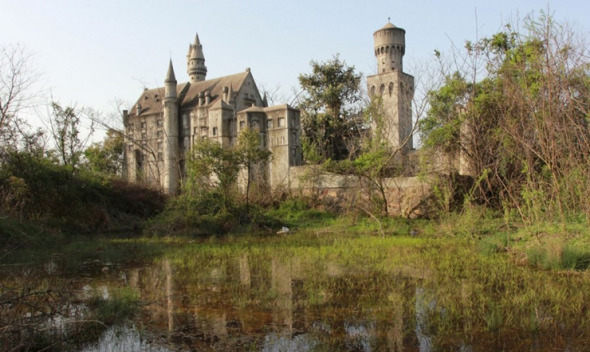

An exotic building is seen in a half-finished park in Wuhan, Hubei province. (Photo/Xinhua)
(ECNS) – As the world's No. 1 country in terms of construction, China adds 2 billion square meters of new construction area each year, accounting for half of the newly added area worldwide. But behind the GDP growth generated from erecting new buildings, there lies an alarming waste of energy and resources.
The waste begins in the planning phase, runs through construction and building usage, and even extends to the dismantling and recycling phase, the Economic Information Daily reports.
Irresponsible planning is a big reason for the waste, as poor regulation by local governments leads to wasted land and repeated construction. Another common practice is the blind pursuit of bizarre and costly architecture.
Pursuit for bigness and foreign style has become a common problem in many domestic building designs in China. Some cities crave for novel landmarks and buy high of designing plans from foreigners.
"China is not so rich to be the 'test field' of foreign architect. Foreign designing firms' demand for 10 percent of the total cost is far higher than the common 2 percent charges," said Wu Jie, an architectural expert from Shanghai.
"Many cities are keen to build landmark buildings and only judge from the exterior, regardless of the environmental impacts, while overseas, industry experts have the biggest influence," said another architectural expert from Shanghai.
Another problem is the low energy-saving standard for buildings, which causes long-term waste.
Guo Zhengxing, professor at Southeast University's Architecture Department, explained that "In Europe, the heat transfer coefficient for doors and windows was no bigger than 1.4 in 2003, while in China the average number was 3.5. If we follow the European standard, we could save around 430 million tons of standard coal each year."
Construction in China suffers from wasted water, electricity, energy, human resources and time. More building materials than necessary are often used, and many materials are worn out during processing and wind up abandoned. Moreover, poor planning leads to waste due to unnecessary transportation and prolonged construction periods, according to the newspaper.
This also results in short-lived buildings. According to Zhang Hua, president of Xian Dai Architectural Design (Group) Co., Ltd, many of China's buildings have life spans equal to only one fourth of those in European countries.
Meanwhile, low quality construction standards shorten the service life of buildings, which are often removed for artificial reasons such as change of planning, economic benefits and pursuit of GDP.
Zhang said the mainstream practice in Europe and Japan is renovating and remolding buildings, resulting in architecture that lasts more than a century.
Although China tears down hundreds of millions of square meters of buildings, the recycling rate of construction debris is low. Many recyclable materials such as waste concrete are only used in primary recycling or dumped in landfills. The technology for recycling building materials is quite mature, but some places still choose environmentally unfriendly materials to cut costs.
Copyright ©1999-2018
Chinanews.com. All rights reserved.
Reproduction in whole or in part without permission is prohibited.